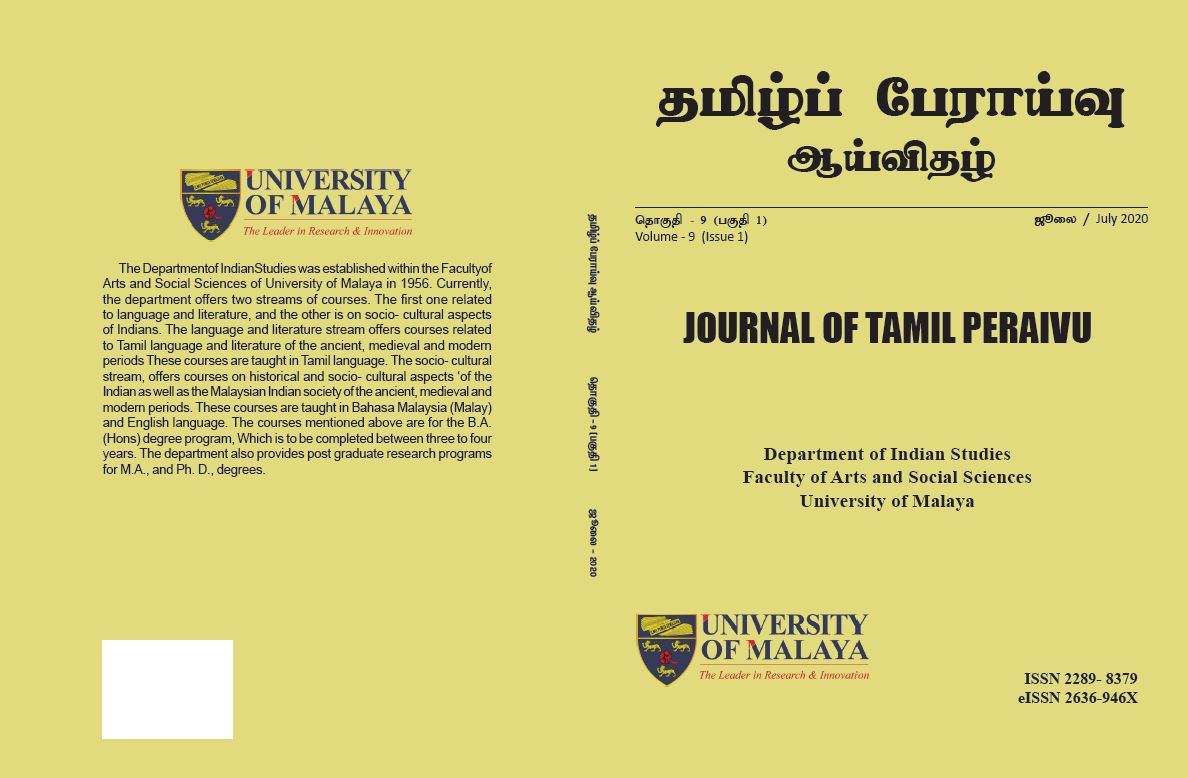கிருமி கண்ட சோழன் (Krimi Kanda Cholan)
DOI:
https://doi.org/10.22452/JTP.vol9no1.5Keywords:
கிருமி கண்ட சோழன், ஆதி இராசேந்திரன், இரண்டாம் குலோத்துங்கன், தில்லை கோவிலில் இறுக்க நிலை, வைணவ எதிர்ப்பு, இராமானுஜர் புறப்பாடு, வணவ சமயத்திற்குச் சோழர்களின் பங்களிப்பு., Krimi Kanda Chola, Adi Rajendra, Kulothungan II, Chidambaram Temple tension, Clash with Vaishnavas, Ramanujas migration, Cholas contribution to Vaishnavism.Abstract
“Kirumi Kanda Cholan” is the reference to the Chola king who died due to disease, which was believed to be caused by his maltreatments against Vaishnavites in his country during his reign. Some historians said that the Chola king was King Adi Rajendra while other sources quoted Kulothuga Chola II as the said king. As the king suffered an unnatural death caused by a disease (cancerous in nature though not diagnosed as such at the time), he was accorded the name “Kirumi Kanda Cholan”. He was a strong advocator of Shaivism and was intolerant of Vaishnavism, which was also practiced by the people under his rule. To demonstrate his aversion towards Vaishnavism, he was said to take the extreme action of throwing the Govindaraja Perumal idol into the sea upon his clash with the priests in Vaishnava Temple in Chitambaram. This incident created tension among the Vaishnavas in Chola country; Acharaya Ramanuja, the main philosopher of Vaishnavism even migrated from Chola country to Mysore due to this inequal treatments. It should be noted that all Chola kings always were recorded to give their full support to every religion practiced in their country.
கிருமிகண்ட சோழன் எனும் சோழ மன்னன் தனது ஆட்சி காலத்தில் வைணவத்திற்கு எதிர்ப்பாகச் செயல்பட்ட தெய்வக் குற்றத்தால் கிருமி நோய்வாய்ப்பட்டு மடிந்ததால் இப்பெயர் பெற்றான். இவ்வாறு இறந்த சோழன் அதி இராசேந்தின் என்றும், இரண்டாம் குலோத்துங்கச் சோழன் என்றும் ஆய்வாளர்கள் கருத்து மாறுபடுவர். இச்சோழ மன்னன் இயற்கையான மரணத்தை அடையாமல் கிருமி நோயினால் துன்புற்று மடிந்ததால் கிருமி கண்ட சோழன் என அறியப்பட்டான். கிருமி கண்ட சோழ மன்னன் ஆட்சி செய்த காலத்தில் வழக்கில் இருந்த சைவம், வைணவம் ஆகிய இரு பெரும் சமயங்களுள் சைவ சமயத்தை ஆதரித்தும் வணவத்திற்கு எதிர்ப்பாகச் செயல்படும் போக்கை கொண்டும் இருந்துள்ளான். வைணவர்களுடன் ஏற்பட்ட பினக்கால் தில்லையில் உள்ள கோவிந்தராசப் பெருமாள் கோவில் சிலையைப் பெயர்த்தெடுத்துக் கடலில் எறிந்த செயலை இச்சோழ மன்னன்தான் செய்ததாகக் கூறுவர். இது வைணவர்கள் அப்போதைய சோழப் பேரரசை எதிர்க்கும் குழப்ப நிலையை உருவாக்கியதோடு; மன்னனின் இச்செயலால் புண்பட்ட வைணவ ஆச்சாரியர் இராமனுஜர் தமிழ்நாடு நீங்கி மைசூர் சென்று வாழ்ந்தார் என்றும் உரைப்பர். ஆயினும் சோழ மன்னர்கள் அவர்களின் நாட்டில் இருந்த அனைத்து சமயங்களுக்கும் ஆதரவு அளித்தவர்கள் எனும் கருத்தையும் இவ்விடத்தில் நினைவில் கொள்ளல் வேண்டும்.



